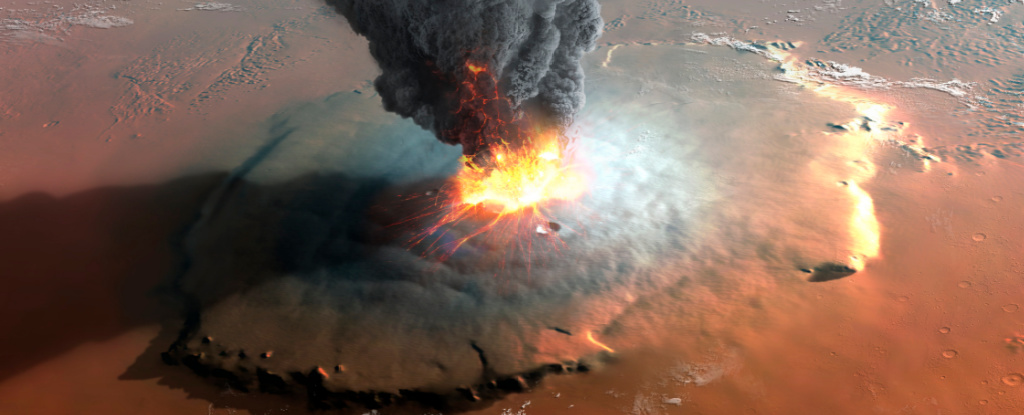For a quiet, dusty lump of a planet we see today, Mars has had a surprisingly violent history, one that could reveal some clues about Earth’s own past.
A new survey of the Martian surface suggests that in its younger years, the red planet was littered with volcanoes that might resemble the rumblings of our little blue dot before it formed tectonic plates some 3 billion years ago.
Planetary scientist Joseph Michalski of the University of Hong Kong and colleagues cataloged the scars of volcanic activity in the planet’s Eridania region in the southern hemisphere, using remote sensing data from multiple orbiters.
Unlike Earth, which has a crust of interlocking continental plates floating atop its viscous mantle, present-day Mars is generally considered a one-plate planet that had active volcanoes once upon a time.
These volcanoes were massive and explosive, the largest being Olympus Mons; a shield volcano 100 times larger in volume than Earth’s biggest, Mauna Loa in Hawaii.
One reason Mars’ volcanoes grew so large is because the red planet lacked tectonic plates to conveniently vent the pressures of a churning mantle. Without the sliding and sinking of plates over and under one another, the geological history of the Martian crust hasn’t been recycled like our planet’s surface, and could contain inklings of how Earth’s own crust might have formed.
“The planet Mars represents a particularly valuable puzzle piece in this regard,” Michalski and colleagues write in their published paper.
Roughly 70 percent of the Martian surface is more than 3 billion years old, and about 45 percent is older than 3.6 billion years.
“Though the crust is heavily impact cratered,” the researchers explain, “the ancient geologic record remains largely intact and therefore provides an invaluable window into early Solar System geological conditions and clues to early crustal evolution.”
Michalski and colleagues’ interest in the Eridania region lay in its intensely magnetized crust, and evidence from the region which suggests it once contained an ancient Martian sea.
Using the orbital data, the researchers identified a huge array of four different types of volcanoes within and adjacent to the Eridania sea: volcanic domes, stratovolcanoes, pyroclastic shields, and caldera complexes likely leftover from a period of vigorous geologic activity some 3.5 billion years ago.
The structure of these volcanoes on Mars was similar to those found on Earth today, but with slightly larger diameters – a result of the lower gravity on the red planet and more explosive volcanism that threw material further afield.
“The diverse volcanism is associated with felsic volcanic compositions which are unlike any other suite of recognized deposits or volcanic region on Mars,” Michalski and colleagues write, adding to the region’s oddball nature.
The topography of the ancient landscape was also revealing. The thickness of the volcanic deposits in the Eridania region, sections of warped and folded crust, and its sagging basins indicated to the researchers that baby Mars’ crust might have been slowly overturned by a precursor to plate tectonics, called vertical tectonics.
The researchers suspect hundreds more volcanoes could be found in the Eridania region, many of which would have probably erupted beneath an ancient sea – which provides a nice parallel to Earth during the Archean period, when Earth was mostly a water world and the earliest forms of life emerged.
“It’s just astonishing to think about the scale of activity in this region,” study author and planetary geologist at the Planetary Science Institute Aster Cowart told journalist Robert Lea for Space.com.
“Seeing a Martian landscape shaped by these processes and preserved in stasis provides us with a great opportunity to investigate planetary landscape evolution in more detail.”
The study has been published in Nature Astronomy.





